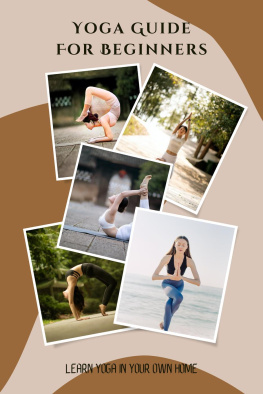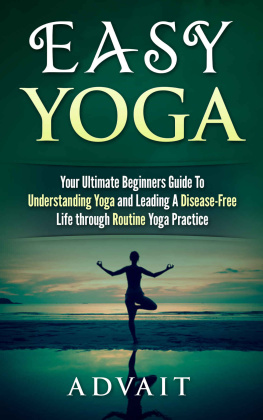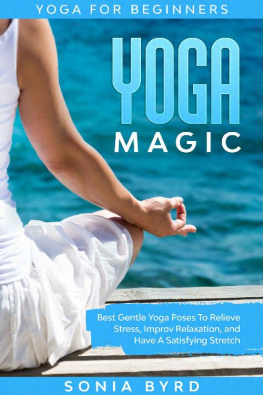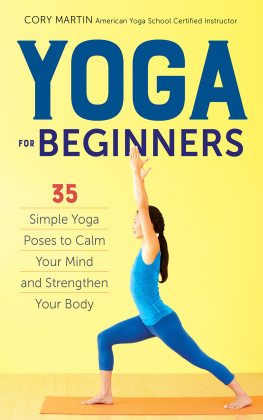Sophie Godard - Yoga: 40 Exercises for Beginners
Here you can read online Sophie Godard - Yoga: 40 Exercises for Beginners full text of the book (entire story) in english for free. Download pdf and epub, get meaning, cover and reviews about this ebook. year: 2012, publisher: Editions ASAP, genre: Romance novel. Description of the work, (preface) as well as reviews are available. Best literature library LitArk.com created for fans of good reading and offers a wide selection of genres:
Romance novel
Science fiction
Adventure
Detective
Science
History
Home and family
Prose
Art
Politics
Computer
Non-fiction
Religion
Business
Children
Humor
Choose a favorite category and find really read worthwhile books. Enjoy immersion in the world of imagination, feel the emotions of the characters or learn something new for yourself, make an fascinating discovery.
- Book:Yoga: 40 Exercises for Beginners
- Author:
- Publisher:Editions ASAP
- Genre:
- Year:2012
- Rating:4 / 5
- Favourites:Add to favourites
- Your mark:
- 80
- 1
- 2
- 3
- 4
- 5
Yoga: 40 Exercises for Beginners: summary, description and annotation
We offer to read an annotation, description, summary or preface (depends on what the author of the book "Yoga: 40 Exercises for Beginners" wrote himself). If you haven't found the necessary information about the book — write in the comments, we will try to find it.
Yoga: 40 Exercises for Beginners — read online for free the complete book (whole text) full work
Below is the text of the book, divided by pages. System saving the place of the last page read, allows you to conveniently read the book "Yoga: 40 Exercises for Beginners" online for free, without having to search again every time where you left off. Put a bookmark, and you can go to the page where you finished reading at any time.
Font size:
Interval:
Bookmark:

Summary
Get Free Sample

Yoga is a discipline of self-discovery, a re-learning of oneself as an entity, which seeks a perfect harmony between the body and the mind, which are inseparable.In the West, the most popular form of yoga, Hatha Yoga, employs poses which aim both to calm the mind and increase muscle tone.
Anyone who practises yoga regularly will find it gives valuable help in everyday life. In difficult times, they will feel stronger and more serene.
The origins of yoga
In the West, yoga is often seen as a series of exercises aiming to make the body more flexible and the mind more relaxed. But yoga is above all a philosophy.
Yoga originated in India, where it has been practised for thousands of years, so it has been able to evolve from master to master, each learning from the experience of his predecessor.
The Yoga Sutra of Patanjali, written more than 2,000 years ago, condenses the yoga philosophy into a collection of sayings. This is a reference work for practising the discipline as well as its philosophy, and is the foundation of Raja Yoga, the Royal Road of Yoga.
Different yoga practices
The meaning of yoga can be seen in the origins of its name yuj means to unite. The search for this union figures to differing degrees, according to the type of yoga practised. So Hatha Yoga, the type most practised in the West, is different from Raja Yoga. It consists of poses which concentrate on meditation and physical exertion, aiming to connect the body and the mind whilst strengthening them together.
In royal yoga, the more spiritual search is closer to Buddhism.
In practice, Royal or Ashtanga Yoga is more closely connected to a way of life, which obeys the eight limbs (ashtanga means eight limbs) or codes which are:
- yama, or self-control, both in action and thought;
- niyama, or engagement in the discipline and respect for its rules;
- asanas, or poses which prepare the body and mind for meditation;
- pranayama, or breath control, which represents the circulation of energy, the vital breath;
- pratyahara, or control of the senses by the mind;
- dharana, or concentration;
- dhyana, or deep meditation;
- and samadhi, the ultimate step in yoga, when the individual being becomes one with the absolute.
Hatha Yoga is concerned with a part of Raja Yoga and four of its limbs: the poses, breath control, concentration and meditation.
Some exercises are not recommended during menstruation. During this period of your cycle, take a break in your training and avoid practising Hatha Yoga.
Hatha Yoga or effort yoga
Hatha Yoga is yoga practised through physical exercise. Hatha means effort in Sanskrit. It is based on the balance of opposing principles:
- the material and the immaterial, represented by the body and the mind;
- the mobility and immobility of the body, in performing the poses;
- stamina, to maintain them, and relaxation;
- effort and becoming calm, both physically and mentally.
Not to forget breathing: inspiration and expiration give rhythm to the movements, and breathing control is essential.
The aim of Hatha Yoga is to rid the disciples mind of all disturbance, by focussing on the self.
Some poses are more difficult to perform than others. They involve movements which stretch muscles and require stamina, and also stability to strengthen weaker parts of the body.
At first the exertion is physical, but the greatest difficulty is in keeping the body still, to maintain the pose, so even the seemingly easy poses need great concentration, and real mental strength takes over from the strength of the body.
The body in the service of the soul
What distinguishes Hatha Yoga from other physical activities is that its prime aim is to bring peace of mind: you use the body to strengthen the mind.
Stress, or mind pollution, brings tensions which directly affect the body: they bend the back, stiffen muscles and pollute the mind. The body is more exposed to pain or injury and because of this the mind also is weakened: aggressive behaviour, instability, depression
Little by little, stressed people lose touch with themselves, and become weak. This phenomenon is increasingly common today, as our way of life is so sedentary. We lose awareness of our bodies, placing all our burdens on our minds, which gradually close up.
The effects of Hatha Yoga
Short term effects
Hatha Yoga uses physical sensations to focus the mind on the present moment.
To perform these exercises as effectively as possible, the disciple should let go and centre themselves. For a while, everyday problems and worries about the future should be left aside. The body releases its tensions and the freed mind can open up again.
Long term effects
Hatha Yoga uses effort to restore harmony and the connection between body and mind, which have been lost.
The disciple has to assume and hold poses they are not used to. They must employ physical stamina, breath control and concentration. The pupil must therefore try to create a close connection between the body and the mind.
Regular practitioners of Hatha Yoga will use what they have learned doing exercises to help manage stressful situations without being overcome. Just as their mind and body have supported them during their physical effort, they will be supported during their mental effort to remain calm and stable.
The mind and the body become more and more flexible, and less vulnerable to physical and emotional pain.
The benefits
- Better breathing.
- Better stress management.
- Greater physical flexibility.
- Calming of the mind.
- Greater self-confidence.
- The ability to maintain a sense of self, with more mental stability.
- A better relationship with oneself and others.
It is particularly beneficial
- For those who are hyperactive or too exposed to stress. Hatha Yoga teaches them to centre themselves. By helping them to be detached from external disturbances, it brings welcome relief from stress.
- For passive people, who are in a state of physical and mental inertia, and want to have more energy. Hatha Yoga allows them to get back in touch with their bodies. In a more toned and flexible body, the mind is livelier and more open to the world.
These exercises are aimed at people in good health.
Take medical advice if you are undergoing physiotherapy, are pregnant or have any illness. Finally, if you feel tired, are in pain or have too much tension, stop the exercises and speak to your doctor.
How to practise
The time
Yoga should be practised on an empty stomach, or at least two hours after your last meal, so as not to interfere with digestion and for you to move with greater ease.
Breathing
One of the particularities of yoga is that breathing is done essentially through the nose, with the mouth closed. You will notice that a good number of poses open up the ribcage to allow more space for breathing, so the capacity of the lungs to fill with air is increased. This way, the muscles and brain receive more oxygen, the body is more ready for effort, and the mind is prepared for concentration.
To maintain this advantage, choose a well-ventilated space, to benefit from good quality air.
The place
Avoid draughts and places which are too cold. Yoga being slow, muscles must be kept warm so they relax more easily, and avoid the risk of being pulled. For the same reason, be careful to warm up, to stimulate the circulation of blood and increase your body temperature.
Font size:
Interval:
Bookmark:
Similar books «Yoga: 40 Exercises for Beginners»
Look at similar books to Yoga: 40 Exercises for Beginners. We have selected literature similar in name and meaning in the hope of providing readers with more options to find new, interesting, not yet read works.
Discussion, reviews of the book Yoga: 40 Exercises for Beginners and just readers' own opinions. Leave your comments, write what you think about the work, its meaning or the main characters. Specify what exactly you liked and what you didn't like, and why you think so.








